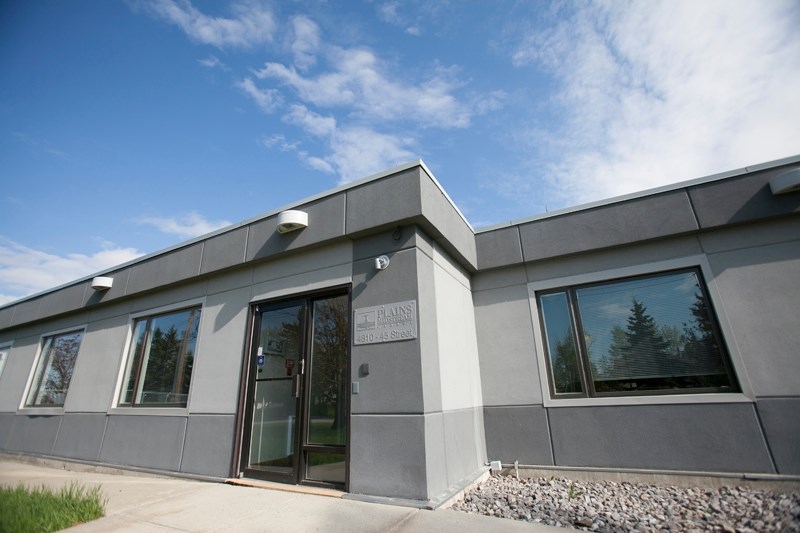Plains Midstream Canada, one of Western Canada's largest pipeline operation companies, has been in the news frequently in the past four months.
In February, Alberta's Energy Resources Conservation Board (ERCB) ordered the company, through four “high-risk enforcement actions” to change a number of aspects of its operations in the wake of a pipeline spill in April 2011 near Little Buffalo, a hamlet located about 680 kilometres north of Olds, that released 28,000 barrels of oil onto more than eight hectares of land.
And last month, the province laid three charges under the Environmental Protection and Enhancement Act that carry fines of $500,000 each against the company for the pipeline spill.
But few people in Olds are aware that the company's nerve centre for its Canadian pipeline operations is here in town, just north of Highway 27 on 49 Avenue.
Only a small plaque identifies the grey, fortress-like building as belonging to the company.
Yet from a control centre at this facility, the company remotely monitors all of its pipelines in Canada, 24 hours a day and seven days a week.
In the case of an emergency such as the April 2011 spill or the June 2012 pipeline spill near Sundre that released between 1,000 and 3,000 barrels of oil into the Red Deer River, control centre operators can shut down a pipeline and dispatch response crews to the site of the emergency thanks to “state of the art” monitoring and alarm systems.
Stephen Bart, the company's vice-president of crude oil operations, described the Olds control centre in an email as “like an air traffic control room for pipelines.”
More than 35 staff work in the control centre, which was built in Olds in 2008 at a cost of more than $10 million and Bart said the town was chosen as a site for the centre due to its central location in Alberta.
“Olds, Alberta, was selected over a number of potential sites given its proximity to our corporate office in Calgary, a central location relative to our pipeline footprint, and (because it's) a vibrant yet affordable community from which Plains was confident it could attract and retain staff,” he said in the email.
According to a statement from the company, once the control centre in Olds was completed, Plains “then relocated a number of its smaller regional control centres to Olds.”
“In some cases staff relocated to Olds with this centralization, while in other cases new staff was hired from Olds and surrounding areas.”
The company also stated in the release that the control centre is responsible for the safety of every single one of Plains' pipelines across the country.
“Plains handles about one-fifth of all the oil produced in Western Canada and it is the control centre's important job to ensure we are safely and efficiently transporting crude oil and other products throughout our extensive Canadian pipeline system,” the statement reads. “They (the centre's operators) are on constant vigil and stand-ready to provide immediate response to any abnormal operating conditions or emergency situations (in the unlikely event one should occur).”
The brackets were included in the company's statement.
The ERCB, however, concluded in a report released in February that the large volume of oil spilt near Little Buffalo two years ago was partly due to “the actions of Plains's (sic) control centre staff” and “operator error”.
The report stated the “root causes” of the operator error were a “failure to have proper leak detection alarm response procedures in place,” a “lack of operator training” and a “lack of supervisory oversight and involvement in decisions to restart the pipeline after a leak detection shutdown.”
Although a leak detection system at the centre worked properly, the report states, the pipeline was, after being initially shut down, “restarted three times throughout the incident before being completely shut down.”
“Plains attributed this to operator error,” the report states.
The ERCB concluded “that Plains's failure to completely shut down the pipeline at the time of the initial indication of a potential leak, its subsequent failure to properly investigate the cause of the alarm, and its subsequent repeated restart of pumping resulted in a much larger crude oil release than if proper response actions had been taken at the first indication of a potential pipeline failure.”
While the ERCB tried to interview the Plains employee in charge of the control centre at the time of the spill, the company told the board the employee was no longer with the company.
“This significantly hindered the ERCB's ability to obtain a first-hand and direct account of the specific sequence of events, the standard processes and procedures, and potential deficiencies in the control centre operator's response to the alarms,” the report states.
One of the four high-risk enforcement actions issued against the company was for it to improve its leak detection and response systems.
In a statement to the Olds Albertan, Plains stated it “undertook a prompt and thorough assessment across our pipeline operations” following the April 2011 spill.
“We have implemented changes to our existing operations and identified ways to decrease the likelihood of a similar event occurring, increasing the timeliness of communicating to stakeholders and minimizing the impacts of an incident.”
The company is also “evaluating the charges arising out of this matter.”
“We are reviewing them with our counsel and the Crown, and will respond formally with our position in due course.”



